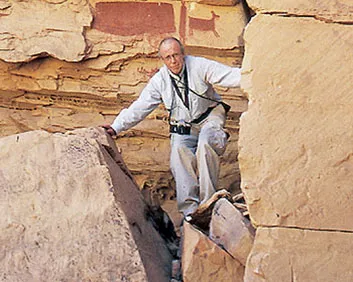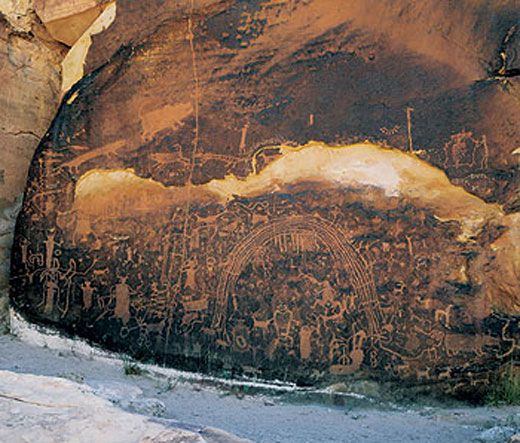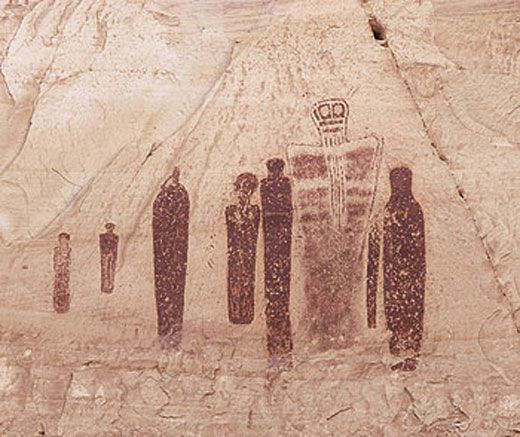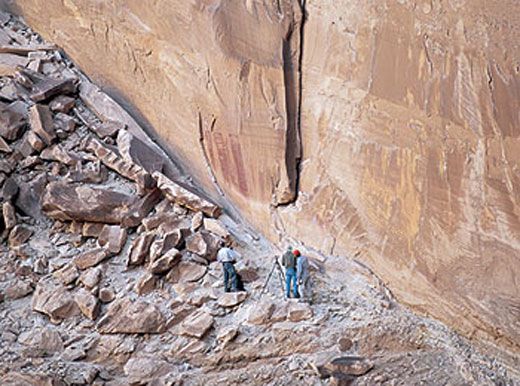Traces of a Lost People
Who roamed the Colorado Plateau thousands of years ago? And what do their stunning paintings signify?
Deep in a high-desert canyon filled with contorted cottonwoods, stunted blackbrush, cactuses and melodious canyon wrens, the “Holy Ghost” hovers above a sandy wash. Surrounded by lesser figures, the striking specter nearly eight feet tall shimmers on the canyon wall under the relentless sun.
Ancient nomads created the larger-than-life image perhaps as long as 7,000 years ago by filling their mouths with red ocher-tinted paint and spraying it out with a mighty burst onto the sandstone. The “Holy Ghost” (p. 50) is the focal point of the Great Gallery, a vast mural some 300 feet long and featuring about 80 figures, located a five-hour drive southeast of Salt LakeCity in Utah’s HorseshoeCanyon. No one knows for sure what the images represent or why they were painted.
David Sucec calls the Great Gallery the “Sistine Chapel” of Utah’s Barrier Canyon—as this style of rock art is called—and says the men and women who painted it were true artists. “It’s clear they weren’t just making images,” he says. “They liked to paint and probably had a tradition of painting and probably had what we would consider masters and apprentices.”
But unlike Michelangelo’s ceiling, the Great Gallery is exposed to the elements. And while many BarrierCanyon paintings remain resplendent, time is dulling them, natural rock spalling is gnawing at them and vandals are desecrating them. The Holy Ghost and others like it are vanishing.
Fourteen years ago Sucec, 67, a former professor of painting and art history at VirginiaCommonwealthUniversity, began to document the thousands of BarrierCanyon images hidden throughout Utah’s labyrinthine canyon country. He enlisted Craig Law, a photography professor at UtahStateUniversity, to join him. The two men journey into Utah’s canyon country each spring and fall. Extreme temperatures prohibit fieldwork the rest of the year. The pair hope to produce a complete record to be used by museums and scholars.
Back when they began, there were thought to be just 160 BarrierCanyon sites on the Colorado Plateau, a vast 130,000- square-mile region that comprises parts of Colorado, Utah, Arizona and New Mexico. At last count, Sucec and Law have visited more than 275 sites, and some rock art connoisseurs believe there could be as many as 400. “I thought it’d take two or three years, and we’d have it done,” says Sucec. “We just continued to find more and more sites.”
More than 500 million years ago, most of what is now the Colorado Plateau, a landscape of colorful buttes, palisades, rock arches and slender red-rock canyons, was covered by ocean. Although mountains began to rise above sea level some 300 million years ago, they were eroded by wind and water to form massive dunes. Eventually the dunes were compacted by erosion into mountains of sandstone. One example is the San Rafael Swell, where soaring canyon walls became stunning palettes for BarrierCanyon artists.
From about 7500 B.C.to about A.D.300, according to Navajo Nation archaeologist Phil R. Geib, small bands of people traveled this harsh landscape, surviving on vegetation and whatever small mammals, fish and birds they could catch with snares and nets. Spears and atlatls (devices used to launch long-shafted darts) were used for deer. Artifacts recovered from a cave in Utah in 1975 include pendants and bracelets made from bones, as well as painted stones and clay figurines.
Some archaeologists who have studied the Barrier Canyon images believe they were created between 1900 B.C.and A.D.300, though Alan Watchman, a research fellow at Australian NationalUniversity, says radiocarbon analysis dates some of them to the Early Archaic period, from about 7430 B.C.to 5260 B.C.Archaeologist Phil Geib also believes the earliest may date to the Archaic period. He notes that a figurine similar in style to BarrierCanyon rock art was recovered in a cave in Utah above a layer of soil dating to around 7500 b.c.Adistinctive style of sandals directly associated with the figurine, he says, dates to around 5400 B.C.
It’s early morning when I follow Sucec and Law, cradling his tripod like a carbine, into the San Rafael Reef. We slip through a 150-foot-deep cleft in the canyon barely an arm span wide in some places. The walls, fluted by floodwaters, are gray, white, pink, bronze and yellow. After perhaps a quarter mile, we come to an expansive rock-rimmed amphitheater where creosote bushes bloom with yellow blossoms on the canyon floor and canyon wrens flit here and there, alighting briefly in piñon and juniper trees that have somehow found purchase in the sandy soil.
Twenty minutes into the canyon takes us around yet another bend and to the base of a cliff perhaps 1,000 feet high. There, about 200 feet above us, I spy the ancient images. Clambering up a slope of rubble from past rockfalls, we work our way to the paintings, very possibly retracing the steps of the artists who made them. The main panel bears a red rectangular block, an anthropomorphic character with antennae, and what appears to be a bighorn sheep. Asecond, presumably older set of images features two anthropomorphic beings. While nobody knows for sure what these figures signify, speculation centers on shamanistic or religious figures.
Edging closer, Sucec raises his hand above several streaks obviously made by the artist. “You can actually see how big this person’s hand was. My hand is bigger than his,” he says. “You can actually see in the smears up here a fingerprint.”
One day, as we rest high above the sandy floor of WildHorseCanyon, I ask Sucec if he and Law will ever find all of the artworks. “Probably not all of them—maybe 90 percent,” he answers. There are simply too many sites in too many canyons. And too often, Sucec tells me, the slant of the sun has to be just right for an image even to be spotted. “Sometimes you have to go back two or three times to do a canyon,” he says. “This canyon is six miles long. It will take us 10 to 12 days to do this. And there are 10,000 canyons.”



